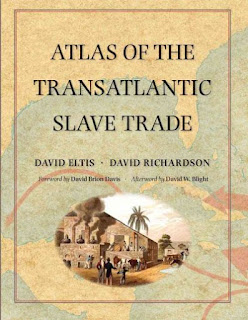 For over 350 years, roughly from 1501-1867, merchants of European descent shipped captive Africans across the Atlantic Ocean to be sold as slaves in the Americas. Spain and Portugal started the trade when they began to colonize territories that they claimed; they had found Native Americans both very resistant to enslavement and very vulnerable to European diseases. Other seafaring European nations also discovered how profitable the slave trade was, and it was unstoppable through the 17th and 18th centuries. Great Britain with many ships out of Liverpool and London became the world's leading slave trading nation until a movement of conscience lead by William Wilberforce convinced Parliament to outlaw the trade in 1807. By the time the last illegal shipload of slaves reached Cuba in 1867, over 10.7 million Africans had been transported, with as many as 20 percent dying at sea.
For over 350 years, roughly from 1501-1867, merchants of European descent shipped captive Africans across the Atlantic Ocean to be sold as slaves in the Americas. Spain and Portugal started the trade when they began to colonize territories that they claimed; they had found Native Americans both very resistant to enslavement and very vulnerable to European diseases. Other seafaring European nations also discovered how profitable the slave trade was, and it was unstoppable through the 17th and 18th centuries. Great Britain with many ships out of Liverpool and London became the world's leading slave trading nation until a movement of conscience lead by William Wilberforce convinced Parliament to outlaw the trade in 1807. By the time the last illegal shipload of slaves reached Cuba in 1867, over 10.7 million Africans had been transported, with as many as 20 percent dying at sea.It has taken a century and a half for scholars to really calculate the impact of the trade in slaves. A key breakthrough has been the creation of the Trans-Atlantic Slave Trade Database, which as of January 2008 included records of 34,934 voyages carrying slaves across the Atlantic. Scholars think this may represent about 80 percent of all voyages in the 366 year period. Geographic analysis of the data has resulted in some unexpected discoveries, much of which is reported in the Atlas of the Transatlantic Slave Trade by David Eltis and David Richardson, a reference book filled with maps, charts, period illustrations, and the texts of slave trading documents.
Several facts may surprise U.S. readers. Only 4 percent of the traffic went directly from Africa to the U.S., with Charleston, South Carolina being the leading slave trading port. Of course, more slaves were eventually were shipped out of the Caribbean to the U.S. For direct shipments, New York and Rhode Island traded more slaves than New Orleans. New Orleans was a latecomer and distinguished itself in the trade of U.S. born slaves after international trading was banned. The ultimate leading slave trading nation was Portugal and almost half of all captives were taken to Brazil.
In the chapter introductions, the authors describe the forces behind the slave trade, which were economic. Slaves provided the labor for the production of in-demand consumer goods, especially sugar, tobacco, and rum, none of which the authors point out were essential or even helpful in providing good health to their consumers. Atrocities in support of vice. One very Wall-Street-economist-like letter from a West Indies plantation owner argues the necessity of slave labor for the providing of cheap products for the world market to insure profits for investors. The low regard for the people who actually produce consumer goods was a problem then as it still is today.
The strength of the Atlas of the Transatlantic Slave Trade may be in the supplemental documents and illustrations as the 189 maps themselves get to be very repetitive to the reader looking for an overall understanding of history. The maps, however, will be very useful for African Americans trying to understand the specific origins of their ancestors. This book is a worthy addition to any public library and recommended to anyone trying to understand American history.
Eltis, David and David Richardson. Atlas of the Transatlantic Slave Trade. Yale University Press, 2010. ISBN 9780300124606.



No comments:
Post a Comment